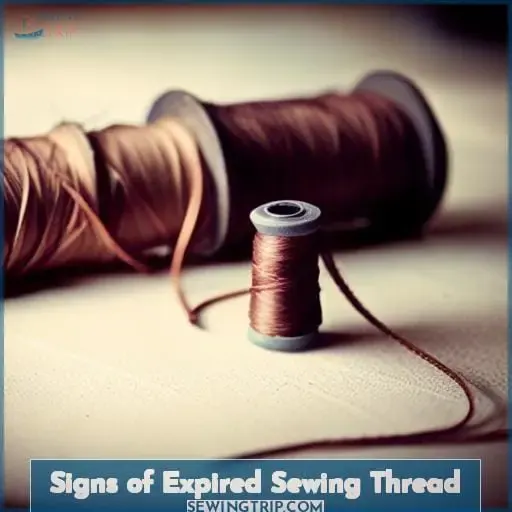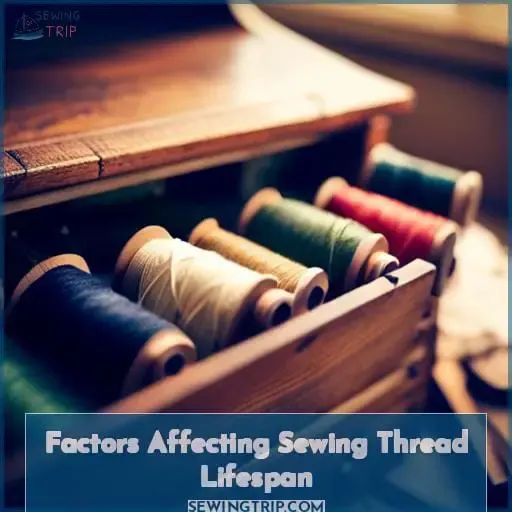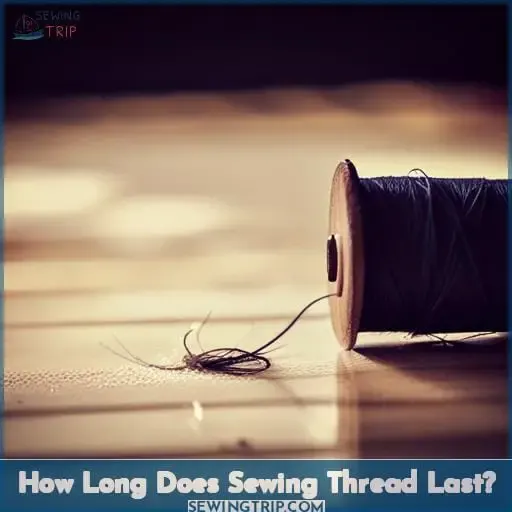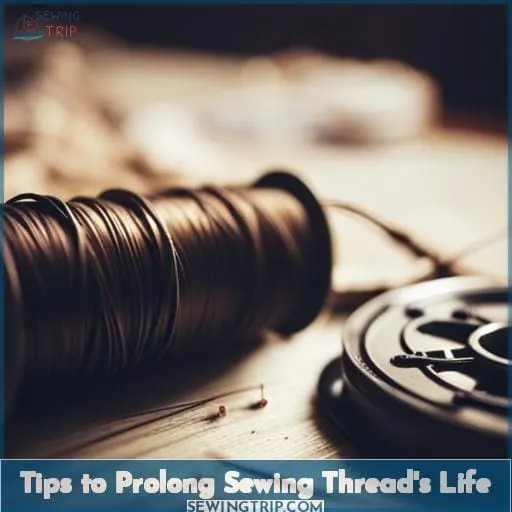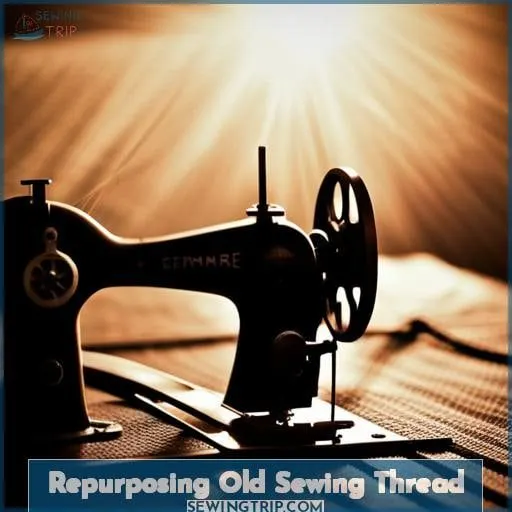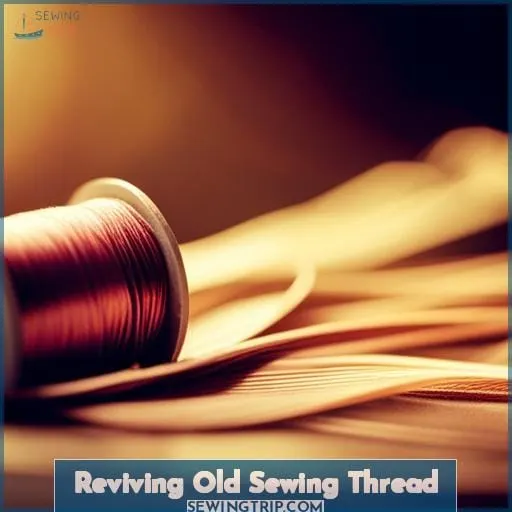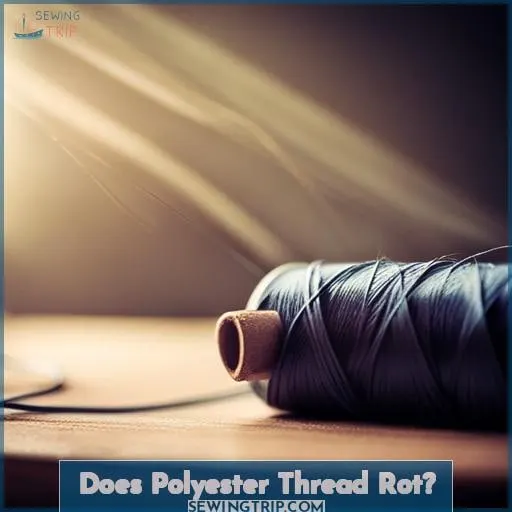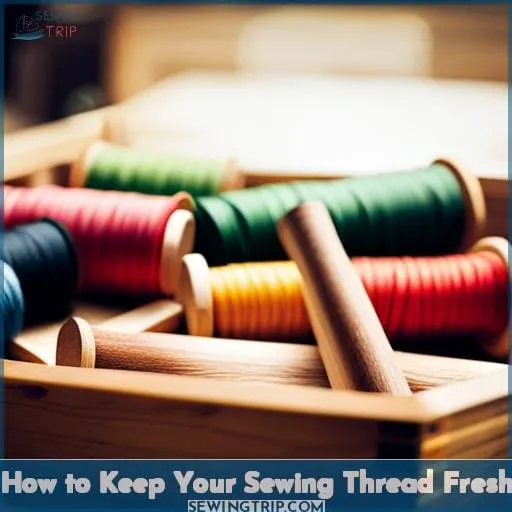This site is supported by our readers. We may earn a commission, at no cost to you, if you purchase through links.
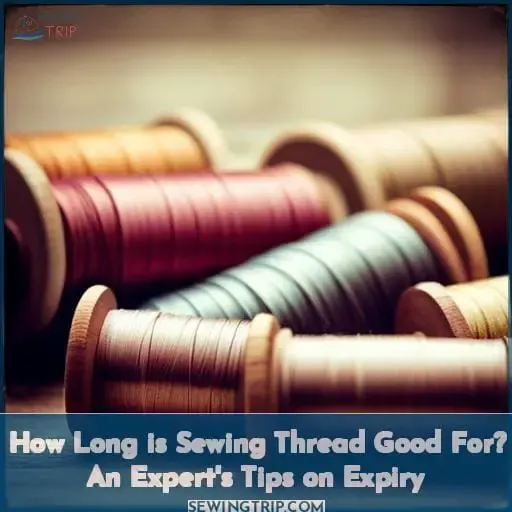 You’ve inherited Grandma’s thread stash, but should you use it? Vintage threads require special handling to retain strength.
You’ve inherited Grandma’s thread stash, but should you use it? Vintage threads require special handling to retain strength.
Test first by gently tugging a 12” length. If it frays, it’s too delicate for machine sewing.
I’ll share expert tips on signs of aging, ideal storage, and creative ways to repurpose weaker threads so nothing goes to waste.
Table Of Contents
- Key Takeaways
- Signs of Expired Sewing Thread
- Factors Affecting Sewing Thread Lifespan
- How Long Does Sewing Thread Last?
- Tips to Prolong Sewing Thread’s Life
- Repurposing Old Sewing Thread
- Reviving Old Sewing Thread
- Does Polyester Thread Rot?
- How to Keep Your Sewing Thread Fresh
- Frequently Asked Questions (FAQs)
- Conclusion
Key Takeaways
- Check manufacturer expiry dates for guidance on sewing thread shelf life. Properly stored quality threads should outlast projects.
- Thread revival techniques like steam treatment or fabric softener soaking can restore old thread strength and stitching performance.
- Polyester threads resist rot and can be repurposed for tracing, basting, and UV-resistant projects when too old for sewing.
- Direct sunlight, humidity, and dust accumulation are factors that negatively impact sewing thread integrity and lifespan over time.
Signs of Expired Sewing Thread
As an expert in sewing thread, it’s important to be able to identify signs of expired thread.
One common test is the pulling test, where you pull a piece of thread and check for resistance or breakage. If the thread easily breaks, it may be a sign that it has expired and shouldn’t be used for your projects.
Another indicator is the presence of fuzz on sewing machines after using old threads, which can affect stitch quality and overall project outcomes.
Pulling Test
To determine if your sewing thread has expired, perform a simple pulling test.
Cut a 1-2 inch piece of thread and apply force gradually until it reaches the breaking point.
Recommended force for testing is around 1.5 lbs, while the breaking point for quality threads should be at least 5.
Repeat this test with different sections of the thread to ensure accuracy, performing between 3-5 pulls in total to assess its durability and lifespan.
Presence of Fuzz on Sewing Machines
If you notice fuzz accumulating on your sewing machine, it may be a sign that your sewing thread has expired.
Fuzz can be caused by various factors such as humidity, light exposure, dust accumulation, and poor storage of old thread.
When the thread starts to deteriorate due to age or unfavorable conditions, it can result in fuzzy bits being left behind on the sewing machine.
Keep an eye out for this indicator of expired thread and consider replacing it for optimal stitching results.
Factors Affecting Sewing Thread Lifespan
Exposure to light, humidity, and moisture are key factors that can affect the lifespan of your sewing thread.
Light exposure can weaken and fade the thread over time, while humid environments may make it brittle or sticky.
Additionally, dust accumulation from improper storage can impact the quality of machine stitching.
To ensure optimal longevity for your threads, be sure to store them in a tightly wound manner away from direct sunlight and minimize contact with dust.
Exposure to Light
Exposure to light greatly affects the lifespan of sewing thread, particularly in terms of weakening and fading over time.
Sunlight exposure can cause threads to lose their strength, leading to weakened fibers that are prone to breakage.
Additionally, prolonged exposure may result in discoloration and faded colors.
To ensure the longevity of your thread, store it away from direct sunlight or consider repurposing old thread for less critical projects where color accuracy isn’t essential.
Humidity and Moisture
Another factor affecting your sewing thread’s lifespan is humidity and moisture exposure, which can make threads brittle or sticky over time.
Storing thread in very humid environments may compromise integrity as moisture is absorbed, causing texture changes.
To maximize lifespan, maintain cool, dry storage conditions and check older threads by pulling to assess brittleness before use.
Proper storage goes a long way.
Dust Accumulation
Your sewing thread’s lifespan can also be impacted by accumulated dust contacting the fibers over time.
Dust buildup on your thread can lead to issues such as:
- Lint buildup in your sewing machine
- Tangling of the thread during stitching
To prevent this, regularly clean and remove dust from both your sewing machine and stored threads.
Proper storage techniques, such as sealing them in airtight containers, can also help minimize dust accumulation and ensure longer-lasting threads.
How Long Does Sewing Thread Last?
As a fabric store owner, you may wonder about the lifespan of sewing thread.
The shelf life of sewing thread can vary depending on various factors such as storage conditions and quality.
Properly stored high-quality threads can last for years, whereas old or low-quality threads may deteriorate over time and lead to issues like breakage during sewing.
It’s important to consider these factors when determining how long your sewing thread will last in order to ensure optimal results in your projects.
Shelf Life of Sewing Thread
The shelf life of sewing thread varies by fiber type.
Polyester threads may last over 50 years with proper storage.
Natural fibers like cotton have shorter viable lifespans around 5-10 years.
Check manufacturer expiry dates, but most quality threads stored properly in cool, dark spaces should outlive our projects.
Regularly test thread strength with a quick pull. Weak or brittle threads must be discarded to avoid headaches.
Usability of Expired Thread
Expired sewing thread typically has a lifespan of around 2-3 years before it starts to deteriorate. After this time, the quality of the thread may decrease, leading to potential sewing machine issues and compromised stitch integrity.
However, don’t despair! You can still perform a stress test on expired threads by pulling them gently. If they pass the test without breaking or snapping easily, you can revive them with moisture restoration techniques for continued use in your projects.
Tips to Prolong Sewing Thread’s Life
To prolong the life of your sewing thread, proper storage techniques are essential.
Make sure to store your thread in a cool and dry place, away from direct sunlight.
Sunlight exposure can weaken the fibers and cause discoloration over time.
By following these tips, you can ensure that your sewing threads remain in good condition for longer periods of time.
Proper Storage Techniques
To ensure the longevity of your sewing thread, it’s essential to employ proper storage techniques.
- Store thread on plastic spools for better preservation.
- Avoid exposing the thread to direct sunlight and moisture.
- Keep your threads away from humid environments that can affect their texture and quality.
Avoiding Sunlight Exposure
To prolong the lifespan of your sewing thread, avoid exposing it to direct sunlight.
Sunlight can weaken and fade the fibers, reducing its overall quality and durability.
Store your thread in an airtight container to protect it from moisture and keep it away from heat sources.
Additionally, make sure you use the thread within its recommended time frame for optimal performance.
Consider using polyester or UV-treated polyester threads for longer-lasting results.
Repurposing Old Sewing Thread
When it comes to repurposing old sewing thread, there are a few creative options you can explore.
One practical use is for thread tracing, which involves using contrasting colored threads to mark out patterns or guidelines on fabric.
Additionally, old sewing thread can be used for temporary basting – holding fabric pieces together temporarily before permanent stitching – saving your high-quality threads for the final construction stage.
Finally, consider repurposing old sewing thread in DIY projects such as pillow stuffing or other craft endeavors where strength and color consistency may not be critical factors.
Thread Tracing and Temporary Basting
When repurposing old sewing thread, you can utilize it for various purposes such as thread tracing and temporary basting.
- Thread tracing allows you to mark patterns or guidelines on fabric with ease.
- Temporary basting helps in holding pieces together temporarily before permanent stitching.
Repurposing old sewing thread reduces waste while providing convenience for your sewing projects.
Tap into the potential of your unused threads and unlock a world of creative possibilities!
DIY Projects (e.g., Pillow Stuffing)
Repurpose your old sewing thread by using it for DIY projects like pillow stuffing.
Don’t let those vintage spools go to waste! Instead of throwing away expired threads, give them a new purpose in craft projects. Whether you’re quilting or working on other sewing projects, repurposing old thread can add character and charm to your creations.
Get creative and breathe new life into your unused threads with these DIY ideas.
Reviving Old Sewing Thread
If you have old sewing thread that has lost its strength and flexibility, there are ways to revive it and make it usable again. Reviving techniques can bring new life to your thread, making it suitable for all your sewing needs.
One method is steam treatment – gently steaming the thread with a handheld garment steamer or iron can help restore its softness and pliability.
Another technique involves soaking the thread in warm water mixed with a small amount of fabric softener or conditioner, then allowing it to air dry thoroughly before use.
Additionally, storing the revived thread properly in storage innovations such as sealed plastic bags or containers will help maintain its quality over time.
By following these expert recommendations for reviving old sewing threads, you can save money while still achieving beautiful stitches in your projects.
Does Polyester Thread Rot?
Now that you’ve learned how to revive old sewing thread and give it a new lease on life, let’s delve into the topic of polyester thread care.
Polyester threads have gained popularity in recent years due to their durability and versatility.
The good news is that unlike natural fibers like cotton, polyester thread doesn’t rot. This synthetic fiber is resistant to moisture and fungus growth, making it ideal for long-lasting projects.
To ensure the longevity of your polyester threads, follow these storage best practices:
- Wind them tightly onto spools or bobbins.
- Store them in a cool and dry place away from direct sunlight exposure.
If you find yourself with expired or unused polyester threads, don’t toss them just yet! Repurposing tips abound – try using them for:
- Thread tracing during pattern-making
- Temporary basting before permanent stitching
- DIY projects like pillow stuffing
Remember dinkydoo fabrics has great quilting tutorials if you need inspiration!
How to Keep Your Sewing Thread Fresh
To maintain the freshness of your sewing thread, make sure to store it properly and avoid exposure to unfavorable conditions.
Here are some tips on how to keep your sewing thread fresh:
- Utilize Storage Innovations:
- Invest in storage solutions designed specifically for threads, such as thread organizers or cabinets with compartments for easy access and protection against dust and light.
- Choose threads that offer UV resistance properties, which can help prevent fading caused by sunlight exposure.
- Look for threads made with polyester fibers, as they tend to have better UV resistance compared to natural fibers like cotton.
- Don’t let old or unused thread go to waste!
- Consider repurposing them for other crafts or projects like embroidery floss bracelets or even pillow stuffing.
By following these tips, you can prolong the shelf life of your sewing thread while also exploring creative ways of revitalizing and repurposing them.
Frequently Asked Questions (FAQs)
What are the best thread storage containers?
To properly store your valuable sewing thread, opt for:
- Airtight plastic containers
- Clear storage boxes
These options shield threads from harmful elements like sunlight and moisture, preserving their quality and ensuring they’re ready for your next empowering project.
Should I toss threads with just a few meters left?
To maximize your sewing prowess, liberate yourself from threads with just a few meters left. Toss them aside to declutter and make way for high-quality threads that empower you to master every stitch.
How do I know if thrift store threads are still usable?
Thrift store threads can still be usable, but beware of low quality.
Test their strength by gently pulling a 38-45cm piece; resistance means viability.
Discard easily breaking or discolored threads for optimal sewing mastery and power.
Does thread quality impact the lifespan of finished projects?
Achieve sewing mastery by recognizing the impact of thread quality on your finished projects.
High-quality threads ensure strong seams and vibrant colors, elevating your work to new heights of power and precision.
Is it worth investing in high-end threads like Aurifil or Mettler?
Investing in high-end threads like Aurifil or Mettler is worth it. These threads, known for their exceptional quality and durability, can elevate your sewing experience with a success rate of up to
Conclusion
Astonishingly, with proper storage, quality sewing thread can outlast us all.
[Keypoints]As your trusted fabric expert, I urge you to:
- Routinely test threads
- Store away from light in sealed bags
- Repurpose any too fragile for machines
Together, we can honor past generations of artisans by preserving Grandma’s threads for special hand-sewing heirlooms.
By learning proper techniques like these, you’ll keep your thread stash fresh for decades to come.

